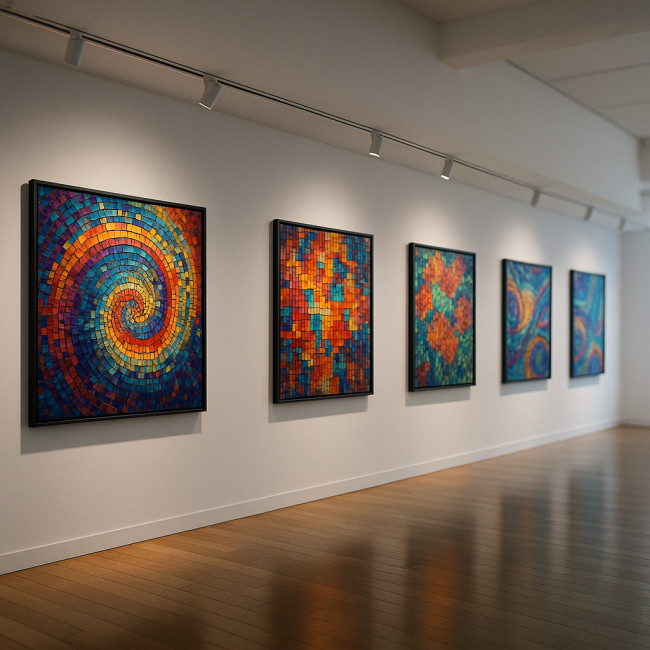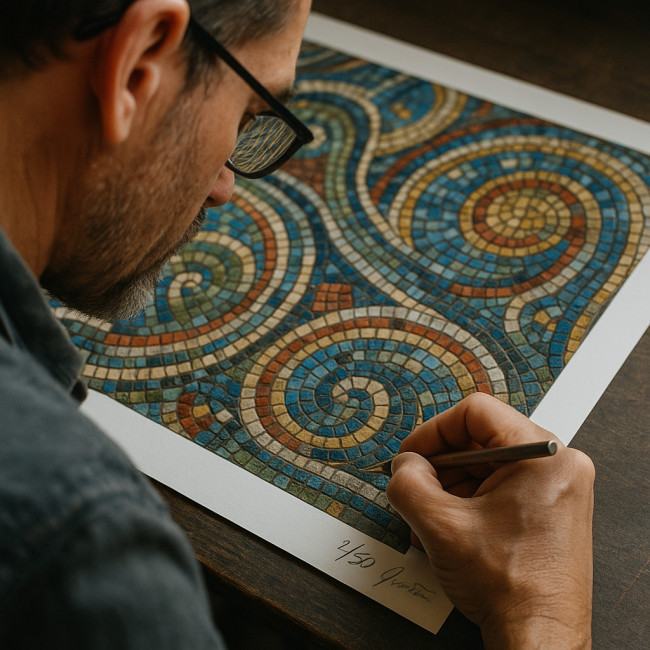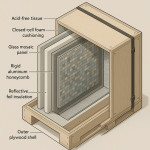Limited edition mosaic prints: licensing paths that multiply passive revenue
Turning high-resolution captures of your mosaics into limited edition prints can unlock steady, passive income—if you select the right licensing path. This guide walks you through proven royalty models, pricing benchmarks, and contract clauses so you keep control of your art while amplifying earnings.
Why limited edition mosaic prints outshine open editions
Scarcity creates urgency. By capping each print run, you:
- Increase perceived value—collectors know only 25, 50, or 100 copies exist.
- Maintain price integrity—no race to the bottom typical of open editions.
- Protect your brand—you decide where and how your imagery circulates.
Marketplaces like premium craft directories confirm that numbered prints command up to 35 % higher launch prices than unlimited counterparts.
Five licensing paths that multiply passive revenue
| Path | Typical Revenue Split | Best For | Scalability |
|---|---|---|---|
| Direct-to-collector sales (e-shop) | 90 – 100 % | Artists with active mailing lists | Medium |
| Gallery co-publishing | 50 / 50 | Prestige positioning | Low |
| Fine-art print-on-demand (POD) | 15 – 30 % | Global reach, no inventory | High |
| Brand licensing deals | 8 – 12 % royalty on net sales | Home décor & lifestyle retailers | Very High |
| Stock art platforms | 5 – 15 % per download | Micro-transactions, wide reuse | Ultra High |
Visualising potential earnings
Source : Art Business News
Step-by-step roadmap to launch your first limited edition
- Digitise flawlessly—hire a photographer who specialises in mosaics. Texture and grout lines must be razor-sharp at 300 dpi.
- Select edition size—common tiers are 25, 50, and 100. Match scarcity to audience size and price tolerance.
- Choose a licensing path—use the table above to weigh control vs reach.
- Draft clear contracts—include term length, territories, print cap, and destruction of plates/screens after run.
- Number & sign—hand-sign each print in pencil outside the image area for authenticity.
- Market in waves—tease on social, drop to mailing list first, then open to public.
Need contract clause inspiration? Our guide on limited edition object design royalty clauses lays out bulletproof language you can adapt.
Pricing benchmarks you can trust

In the pricing conversation, context is everything. Collectors pay a premium not just for the ink on paper, but for the narrative, archival guarantees, and scarcity your certificate conveys. When you benchmark, remember to factor production inputs—cotton rag substrate, pigment longevity tests, embossing stamps—as well as intangible elements like artist reputation momentum, previous auction results, and social proof metrics. Transparent logic around your pricing ladder reassures buyers that today's valuation has room to appreciate, which in turn accelerates early conversions and word-of-mouth buzz.
- Small format (30 × 30 cm) limited to 50: US$150 – 250 per print
- Medium format (60 × 60 cm) limited to 25: US$350 – 550 per print
- Large format (90 × 90 cm) limited to 10: US$950 – 1 400 per print
Bundle incentives—offer the first five buyers framing at cost or free shipping to accelerate sell-through.
Legal guardrails that protect your IP
Include these clauses in every licensing agreement:
- Print cap—fixed number plus a maximum of five artist proofs (A/P).
- Territory—specify countries; use “worldwide” only when royalties justify dilution.
- Audit rights—allow inspection of sales records each quarter.
- Termination for breach—30-day cure period, then automatic rights reversion.
Explore detailed wording in this pattern-licensing playbook.
Distribution channels: own store vs partners
Your e-commerce site
Pros: full control, 90 %+ margin, direct customer data. Cons: marketing budget on you.
Fine-art galleries
Pros: prestige, built-in collectors. Cons: 40 – 50 % commission, slower payment cycles.
Specialist print-on-demand platforms
Pros: zero inventory, global fulfillment. Cons: lower margin, limited edition integrity relies on platform honesty.
Brand partnerships
Homeware or fashion brands pay royalties to feature your mosaic imagery on products. Read how 3D previews speed pitches in this 3D mock-up guide.
Marketing tactics that convert browsers into buyers

Effective marketing for limited editions hinges on sequencing and emotional resonance. A well-timed pre-launch nurture sequence warms up your community with studio teasers, then shifts to concrete scarcity signals such as edition caps and low serial numbers remaining. Reinforce urgency through cross-channel touchpoints—Instagram carousel, short-form video, and VIP SMS drop—so that collectors experience coordinated momentum. Layer this with authoritative third-party validation, like curator testimonials or behind-the-scenes articles, to convert hesitant browsers into decisive buyers.
- Story-driven launch emails—share the location, history, or cultural motif behind the mosaic.
- Countdown timers—show remaining prints to trigger FOMO.
- Behind-the-scenes reels—texture zoom-ins win clicks on social feeds.
- SEO-rich alt tags—use “limited edition mosaic prints” in image metadata to surface on search engines.
- Press outreach—target architecture and interior design magazines for bigger ticket buyers.
For deeper storytelling techniques, visit our article on enhancing mosaic galleries.
Common pitfalls and how to avoid them
- Over-sized editions—printing 500 copies dilutes scarcity and resale value.
- Poor color calibration—mismatched grout tones erode collector trust.
- No resale certificates—buyers value paperwork that proves authenticity on secondary markets.
- Ignoring shipping insurance—tile-textured prints often ship flat; insure for full retail price.
FAQ
- How do I decide the perfect edition size?
- Match quantity to audience size and price point. Emerging artists often start at 25–50 copies to maintain exclusivity while covering costs.
- Can I mix licensing paths for the same image?
- Yes, but stagger rights: release a 25-print fine-art edition first, then license as a pattern for home décor after the edition sells out.
- What paper stock best simulates mosaic texture?
- Heavyweight archival cotton rag (≥300 gsm) with a slight cold-press tooth enhances tile edges without introducing glare.
Quick knowledge check
Action plan
1) Pick your first high-impact mosaic image. 2) Decide edition size and preferred licensing path. 3) Draft contracts and line up production vendors. 4) Launch with a scarcity-driven campaign. Ready to start? Download our free checklist and turn your mosaics into recurring income today.











